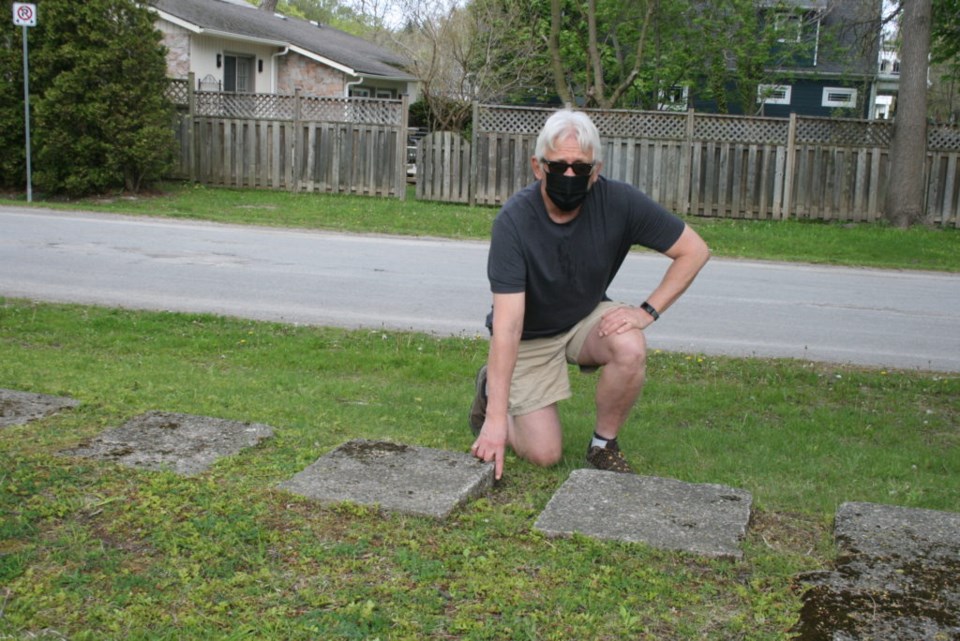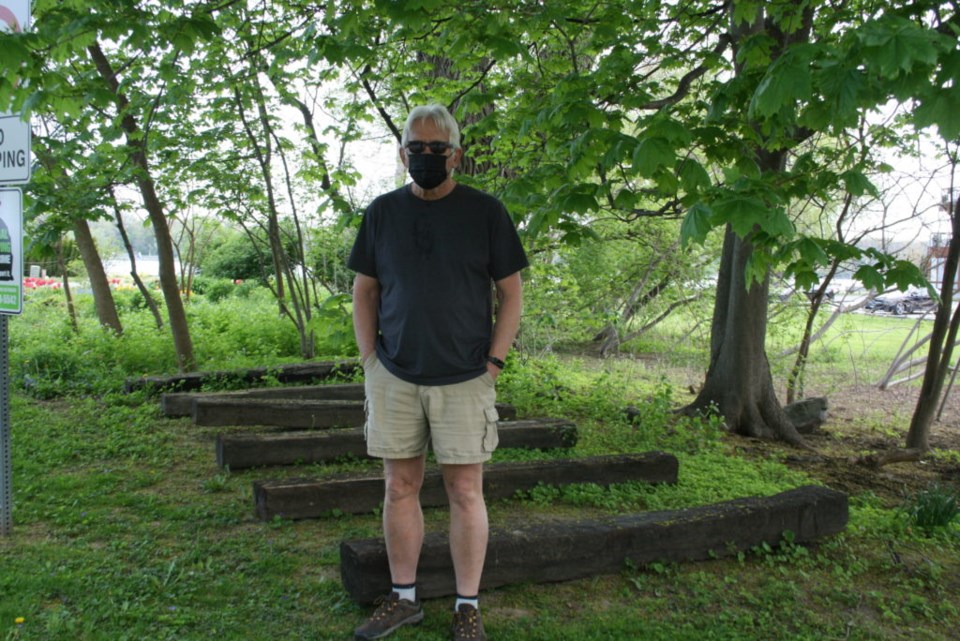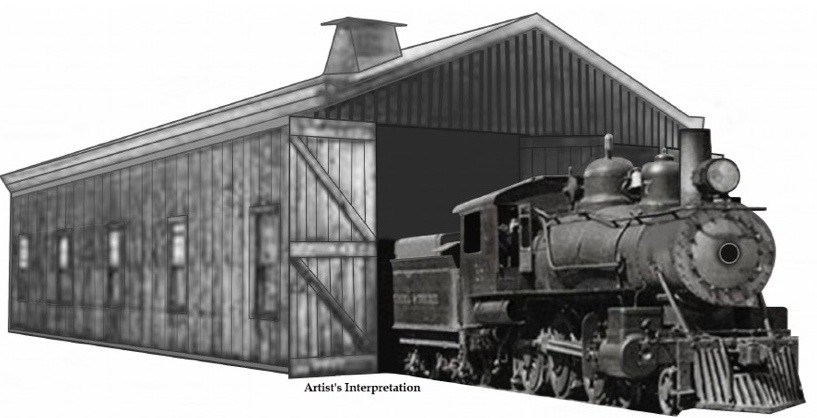
A group of volunteers is hoping to receive approval from the town to acknowledge and commemorate Niagara-on-the-Lake’s railroad history in the Dock Area.
Beginning in 1854 with the arrival of the first steam engine, the dock area of Niagara-on-the-Lake became an important factor in moving people and goods between Toronto and Buffalo. Coal was often unloaded in NOTL, while peaches and other tender fruit were loaded at the docks to be taken to steamers for the trip across the lake. Trains were also used during the two World Wars to transport troops.
At the May 10 committee of the whole meeting, River Beach Drive resident Ron Simkus made a presentation to councillors focusing on the site of the old engine house, which, until it was torn down in 1926, sat about 200 feet south of the railroad turntable.
As the steam-engine trains would arrive, they would be unloaded, then the engine would enter the turntable, where railway workers would use levers to turn the track around. The engine would either get set for a return journey, or head to the nearby engine house for repairs.
Today, at the site of the turntable, located fittingly on Turntable Way, locals and tourists alike can stroll the beautiful garden, plotted around the original circular stone layout and maintained by local residents Pat Hartman and Jim Reynolds.
Just a short stroll south, those same visitors might also come upon another series of stones. These are laid out in a rectangular shape, arranged eight feet wide by 34 feet long. According to Simkus, this is the footprint of an engine repair bay used by mechanics to access the bottom of the train from below.
“It was really quite a significant site,” said Simkus. “In its day, it was 75 feet long and 40 feet wide, a gigantic structure that housed two bays for locomotives, one for repair, and one for starting up.”
Working with local author Peter Mulcaster (Off to Paradise Grove: A Railway History of Niagara-on-the-Lake), Simkus discovered that the stones themselves are actually the tops of a solid foundational wall, with notches cut out to hold railway ties.
“The repair pit itself in the centre was six feet deep,” he explained. “It probably had steps going down to it. When a locomotive straddled this structure they could work underneath to perform repairs. It was abandoned in 1926, and the rails were removed. The facility was basically filled with trash and covered over.”
The vision of Simkus and the other volunteers is to use the remaining, mostly-buried structure to restore the rails on the repair pit using its original configuration. They don’t plan to dig the original pit out, but instead use the 24 recesses cast into the pit walls to hold standard railroad ties cut in 24-inch lengths. Then, each rail would be topped with a tie plate on which the rail would rest. Finally, the wood tie, tie plate and rail would then be fastened together with steel spikes pounded through the holes in the plates.
“When I talked to some of the people from the Heritage Trail committee, and some of the railway enthusiasts in town,” explained Simkus, “there’s no section of rail that anyone can point to in the town. Yet this particular structure was purpose-built exactly for that, to house two rails in parallel, for a length of 34 feet.”
Simkus went on to explain a five-step process that would be followed to restore the site. It would include careful removal of the soil blocks to replace them with a pre-cut railroad tie set into the recess it was intended for. All the moss and soil cuttings would be stored for archaeological review if necessary, he says.

Interestingly enough, the recent demolition of a house at 93 River Beach Drive, the Goring Ball home, turned up six railroad ties from the period during which the dock area railroad was operational. These have been set aside in hopes of using them for the restoration.
As well, Simkus has reached out to PGM Rail Services in Niagara Falls. They specialize in restoring old rail stations, including the Freeman Station on Fairview Street in Burlington. The rails, plates and spikes needed for the engine house restoration would be acquired from PGM. The company’s owner, Peter Murdza, grew up in NOTL and is willing to supply the labour for the installation.
“The rails would be set on either side of the pit,” Simkus assured councillors at last week’s meeting. “There is no need for surveying, no need for locates, no need to construct any type of base or foundation, no need for levelling or ballast material. And in no way would we alter or modify the existing heritage structure as it stands today.”
Simkus stressed during the online meeting that all of this work would be completed at no financial cost to the town. As PGM would be doing the installation, he also claimed the project would not put any burden on staff time. In addition, Simkus says the whole project could be completed in as little as a single day.
Speaking with Simkus on site Saturday, his enthusiasm for the Dock Area is palpable. He guides his visitor through the two sites, explaining their significance and outlining clearly the plans he and the others are proposing. He drops in some history along the way (those ties were salvaged from the site of the old fish house at 93 River Beach Drive) and points out that the rocks lining the nearby parking lot were actually removed from the turntable site in 1985 and are slated to one day be returned to their home.
Living right next to the turntable, he’s eager to see the town’s plans for the Dock Area to start coming to fruition.
“In 2015,” Simkus tells The Local, “after 10 years of consultation with the public, the town agreed on a Dock Area master plan, which included five historical sites. They were each supposed to be commemorated by a plaque.”
He acknowledges that flooding in the area in 2017 and 2019 was most likely responsible for pushing back some of those plans. Town resources set aside for the Dock Area were necessarily put into play for sandbags and pumping equipment to mitigate the flooding.
But he and the other volunteers are ready to get things moving, and they’re willing to foot the bill themselves.
Simkus has commissioned designs for two bronze plaques, one each for the turntable and the engine house. He is currently gathering estimates from some foundries for the plaques, and says he has committed to paying for them.
“Because the two of them (turntable and engine house) were so intertwined,” he says, “we decided it was best for us to develop a plaque in recognition of the engine house itself. Both of these have been reviewed with the heritage planner.”

The Dock Area master plan also calls for signs at the restored culvert at Balls Beach, along the waterfront to commemorate the Teenie H fishing boat, and another on Delater Street at the site of an old horse watering trough.
For years Simkus has been well-known to the town for his frequent updates on the water levels at Balls Beach. A retired mining engineer and executive, Simkus has been involved in the restoration of mines all over the world, including in South America, where they were digging near ancient Incan ruins. Most recently he was involved in an excavation in Romania that was situated near old Roman ruins.
Since moving here in 2010, he has had a unique perspective on the Dock Area, his house situated in a way that he and his wife have taken on the role of sentinels. He keeps an eye on the beach area, and offers his engineering expertise to the town whenever he has a chance. He also sends out regular emails with water level updates to more than 100 people.
As for the engine house project, he hasn’t nailed down a timeline yet, with so many factors coming into play, including when PGM Rail Services might be available to do the installation. But he sees the restoration and the installation of the plaques as a timely endeavour.
“After all this COVID nightmare of 2020,” he says, “and now going into 2021, everybody in this community wants something really positive to happen. And this is something that everybody can get involved in and be proud of. That’s why we’re doing it.”
The presentation by Simkus was accepted positively by the committee of the whole, and the following day his proposal was passed on to the town’s Heritage Committee. He expects to speak to the Heritage Committee on June 8.